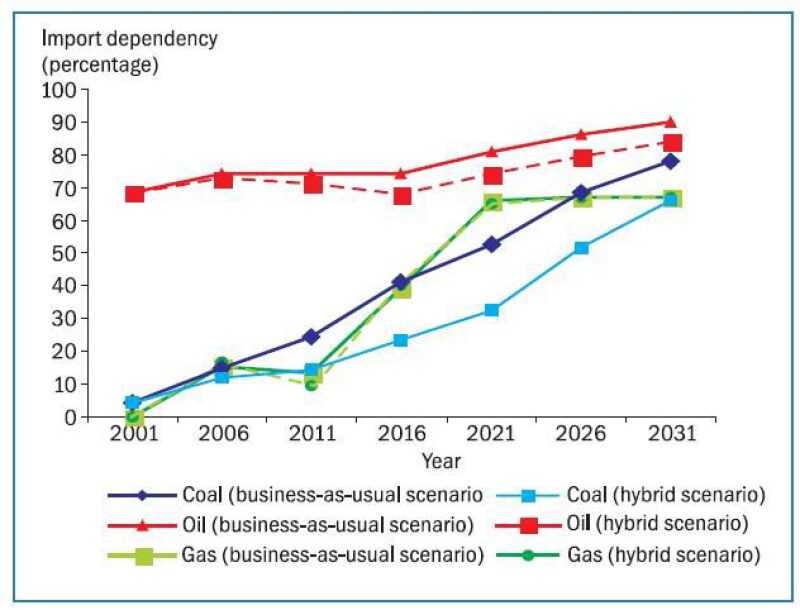Oil was first discovered in northeast India in 1889 in the town of Digboi, Assam. However, India remains a vastly unexplored territory with only a small percentage of its 26 sedimentary basins (2.14 million km2/1.21 million sq mi) under active exploration or development.

Since their discovery in 1974, the massive Mumbai High fields constitute the majority of the domestic hydrocarbon production. To meet growing energy needs (and offset declining production and drilling inventory), the government of India launched a strategic public-private initiative to spur the development of indigenous hydrocarbon resources with the New Exploration and Licensing Policy (NELP). Prior to NELP, exploration was dominated by public sector firms such as Oil and Natural Gas Corporation Ltd. (ONGC) and Oil India Ltd. The motivation for NELP is to leverage private sector participation to help reduce India’s import dependency, which is projected to exceed 50% for coal, oil, and gas by around 2020 (Fig. 1).
The scope of NELP includes an “all of the above” approach to hydrocarbon resources with a focus on exploiting unconventional resources such as gas hydrates. In this article I summarize key findings from recent gas hydrate appraisal initiatives in India undertaken as part of the National Gas Hydrate Program (NGHP).
Gas Hydrates in India
Gas hydrates are clathrates of natural gases (mainly methane), which are captured in water ice crystals. These clathrated compounds have been discovered in sediments worldwide wherever low temperature, high pressure, salinity, and sediment organic concentrations are conducive to their formation.
Recent academic and industrial efforts to investigate and explore naturally occurring gas hydrates have expanded and deepened our knowledge of the distribution and occurrence of gas hydrates in deep-sea sediments and permafrost regions. Globally, it is estimated (Fig. 2) that about 1,226 Tcm (43,311 Tcf) of natural gas is considered to be entrapped in the natural gas hydrates. Due to this vast energy resource potential of gas hydrates, many countries such as the United States, Canada, Japan, India, Korea, China, and Taiwan have undertaken dedicated national gas hydrate research programs. Gas hydrates are in the research and development (R&D) stage and no commercial production is being done anywhere in the world.

Gas hydrate resources are huge in India (26.4 Tcm/933 Tcf) and potentially represent a global energy game changer if the technologies for gas production from hydrate reservoirs are techno-economically established. Several initiatives have been undertaken by NGHP in India for gas hydrate exploration in deepwater offshore. The dedicated gas hydrate coring/drilling/logging-while-drilling/measurement-while-drilling operations were carried out under NGHP Expedition 01 in 2006 in four Indian offshore areas: Krishna-Godavari basin (KG), Mahanadi, Andaman, and Kerala-Konkan, which established the presence of gas hydrates in the KG, Mahanadi, and Andaman deep offshore areas.
To date, three primary classes of methods have been considered for production of methane from subsurface gas hydrates: thermal stimulation, depressurization, and chemical injection. Currently, there has been limited analysis or field testing of gas hydrate production from other gas hydrate occurrence types, and production from those deposits will require development of as-yet unidentified technological approaches.
The NGHP Expedition 01 in 2006 established that huge amounts of gas hydrate deposits are present in the Indian deepwater areas, particularly in KG and Andaman deep offshore. However, the discovered gas hydrates are not producible with the current technologies as they exist in fractured shale and clay-dominated reservoirs.
Therefore, studies were carried out from 2007 to 2013 to identify the gas hydrate occurrences in sand-dominated reservoirs in the eastern offshore—namely, the KG and Mahanadi deep waters. A key partner in the NGHP, ONGC carried out geological and geophysical studies in an area of about 10 000 km2 in KG and Mahanadi deep offshore for the identification of sites for NGHP Expedition 02 with special emphasis on gas hydrate occurrence in sand facies. NGHP-02 was executed by ONGC in 2015, wherein 42 gas hydrate wells have been drilled/cored in KG and Mahanadi deep offshore areas.
NGHP-02 established the existence of a fully developed gas hydrate petroleum system in the KG basin, and producible gas hydrates have been discovered in KG offshore sand reservoirs. In view of the encouraging results, further extensive studies are being carried out to assess the gas hydrate resource potential, reservoir characterization, reservoir delineation, planning for pilot production testing, and techno-economic analysis of gas hydrate producibility. NGHP Expedition 03 for pilot production testing is planned during 2017–18.
Gas hydrate exploitation is still in the R&D stage, and global efforts for the assessment of viable technology for its exploitation are still on and will take some time for commercialization. Hydrate gas may soon prove to be the catalyst for the next surge in energy industry activity. R&D organizations around the world are defining and developing multiple techniques to explore and exploit this resource as the next addition to the expanding clean and affordable energy portfolio.
Bibliography
Collett, T. et al. 2008. Indian Continental Margin Gas Hydrate Prospects: Results of the Indian National Gas Hydrate Program (NGHP) Expedition 01. International Conference on Gas Hydrates 2008, Vancouver, BC, Canada.


